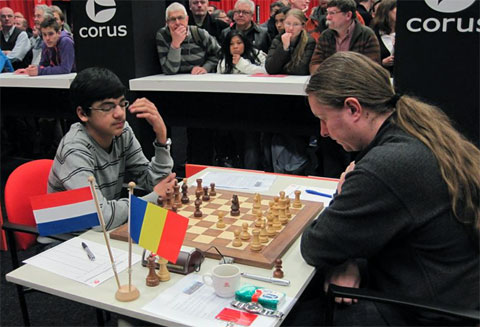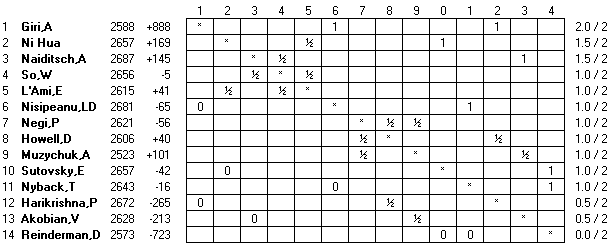


Winning starts with what you know
The new version 18 offers completely new possibilities for chess training and analysis: playing style analysis, search for strategic themes, access to 6 billion Lichess games, player preparation by matching Lichess games, download Chess.com games with built-in API, built-in cloud engine and much more.
![]()
Anish Giri (15) is a man of few words. Do his classmates think he is weird for playing chess so much? No. Is he nervous about his upcoming tournament? No. Does he want to become the best chess player in the world? Yes. He can be somewhat shy, his mother Olga explained when NRC Handelsblad visited the Giri home in Rijswijk. But he does not seem shy in the least if you ask him what his favourite opening is. He laughs in your face. “I am not going to tell you that,” he scoffs. “They might be translating this newspaper!”

Anish Giri in Wijk aan Zee
The Dutch chess community is brimming with anticipation. Giri, a Russian native, has lived in Rijswijk for two years and is registered as a Dutch national with the international chess federation FIDE. He just might be the next Dutch superstar. He became a grandmaster at the tender age of 14, in September he became the youngest player ever to win the Dutch chess championship. According to the Dutch grandmaster and four-time national champion Hans Ree, Giri is a rare talent indeed. “Tactical insight is common in young players,” he said. “Patience is not. But Giri has it.”

One year ago in Wijk: Anish Giri, 14, made his final GM norm [photo
John Nunn]
At last year’s Corus tournament, Giri gave a stunning demonstration of the former quality. The English grandmaster, John Nunn, reigning world champion of chess puzzle-solving, was visiting the tournament when the Armenian, Levon Aronian, decided to throw him a nice challenge of his own making: white to move, mate in three. He jotted the position on a slip of paper, and Nunn set up the pieces. It turned out to be a tough challenge indeed. Metres away, Anish cast a glance at the board. Twenty second later, he spoke. “The position is wrong. There are too many solutions,” he said, quickly rattling off a few. Giri was right. Aronian had forgotten to note a pawn when he wrote down the position.

Anish Giri and Vassily Ivanchuk analyse their drawn game at Univé Hoogoveen
in October 2009
Back to openings: Anish studies them using ChessBase, a database containing four million games, as he was more than happy to demonstrate seated behind his laptop in his attic. He prefers discussing his game with a chessboard handy. Anish usually studies games between players boasting ratings in the 2,600s. He himself is currently rated 2,588 by the FIDE, well over the grandmaster cut-off point of 2,500. The highest-rated player in the world, 19-year old Magnus Carlsen, stands at a lonely 2.810 points.

Anish Giri, 15, grandmaster and Dutch Champion
Pieces flew over the virtual board as Anish clicked his way through a game. Chessbase allows him either to stick with a past game as it was played, or diverge from it by introducing new moves. The computer then helps out by suggesting possible follow-up moves. But it is not always right, Anish said. Its suggestions can be bland or too risky. Only recently did Anish start practicing with a coach.
Time for some real chess. Anish has decided to play a game of bullet on Playchess.com. In bullet chess, each side gets only one minute to play. His youngest sister interrupts him a lot while playing – which doesn’t seem to annoy him at all. A player going by the name of Karnatakagahan challenges him. In the first game, Karnatakagahan offers Anish a draw, which he turns down, only to lose later. In the second match, Anish makes a comeback, wiping his opponent off the board. Karnatakagahan goes offline immediately after that.
That is how Anish spends most of his days: school, some TV, a couple hours of analysing games, playing a few, and perhaps reading a book about chess, then off to bed. Aside from chess, he enjoys action movies, the Black Eyed Peas and table tennis.
Full report at NRC Handelsblad (in English)

A dramatic encounter: GM Pentala Harikrishna, India, vs GM Anish Giri, Dutch
champion
Giri,A (2588) - Harikrishna,P (2672) [D17]
Corus B Wijk aan Zee NED (1), 16.01.2010
1.d4 d5 2.c4 c6 3.Nf3 Nf6 4.Nc3 dxc4 5.a4 Bf5 6.Ne5 e6 7.f3 Bb4 8.Nxc4
Nd5 9.Bd2 Qh4+ 10.g3 Qxd4

11.e4N. This, many experts concluded, was a new move that the 15-year-old GM had found in home prep. But Anish revealed to us that he had been "out of book" since 8...Nd5 (which Garry Kasparov cynically called "a well-known losing move"), and that he had found 11.e4 over the board. 11...Nxc3 12.bxc3 Bxc3 13.Ra2

13...Bxe4. The alternatives were not so pleasant: 13...Bg6 14.Qb3 with a double attack on the bBc3 and the bPb7. 14...b5 15.Bxc3 bxc4 16.Qxb8+ Rxb8 17.Bxd4 wins for White, and 13...Bh3 14.Qb3 (14.Bxh3 Qxc4) 14...Bxf1 15.Rxf1 Bxd2+ 16.Rxd2 Qc5 17.Qxb7 0-0 18.Qxa8 Qxc4 19.Qxa7 leaves White an exchange up and a very promising game.
14.Qc1 Bd3 15.Qxc3 Qxc3 16.Bxc3 Bxf1 17.Rxf1.

White has a piece for three pawns. Our chess engines evaluate the position as around two pawns better for White. Anish goes on to win the game in fine style. 17...0-0 18.Ke2 b6 19.Rd1 Na6 20.Rd6 Rfc8 21.Ne5 c5 22.a5 Nc7 23.axb6 Nb5 24.Rd3 axb6 25.Rb2 Nc7 26.Nc4 Re8 27.Nxb6 Ra6 28.Kd2 e5 29.Nd5 Ne6 30.Bxe5 c4 31.Nb4 Ra1 32.Re3 Rd8+ 33.Kc2 Rh1 34.Re2 Rdd1 35.Kc3 Rdf1 36.f4 h5 37.Kxc4 h4 38.Nd5 Rc1+ 39.Rbc2 hxg3 40.hxg3 Rxc2+ 41.Rxc2 f6 42.f5 Nf8 43.Bf4 g6 44.fxg6 Kg7 45.Ra2 Kxg6 46.Ra6 Nh7 47.Kd3 Re1 48.Ne3 Nf8 49.Ke4 Nd7 50.Rd6 Nf8 51.Kf3 Rb1 52.Kg4 Re1 53.Nd5 Nh7 54.Bg5 Re5 55.Nf4+

1-0. For this game Anish won the the 250 Euro best game prize for the round. [Click to replay]
In the second round Anish Giri faced a world class GM, second seed in this tournament. Liviu-Dieter Nisipeanu of Romania had the white pieces.

Nisipeanu,LD (2681) - Giri,A (2588) [C42]
Corus B Wijk aan Zee NED (2), 17.01.2010
1.e4 e5 2.Nf3 Nf6 3.Nxe5 d6 4.Nf3 Nxe4 5.c4 Nc6 6.Be2 Be7 7.0-0 0-0
8.d4 Bf6 9.d5 Ne7

10.Nd4N. A new move by the Romanian GM. 10.Na3 Re8 11.Nc2 h6 12.Re1 a5 13.Rb1 Bf5 14.Be3 Qd7 15.Nfd4 Bh7 16.Bg4 Qd8 17.Qe2 c6 18.dxc6 bxc6 19.f3 Nc5 20.Rbd1 Qb6 21.b3 Rad8 22.Rd2 Be5 23.Kh1 Qc7 24.Bg1 Bf4 Kholmov,R (2475)-Raetsky,A/Voronezh 1988/EXT 1999/1-0 (41)
10...Re8 11.Na3 Nf5 12.Nac2 Nc5 13.Nb3 Bd7 14.Nxc5 dxc5 15.Bd3 a5 16.Rb1 h6 17.Bd2 b6 18.Qf3 Nd6 19.b3 Be5 20.h3 f5 21.Rfe1 Qf6 22.Re2 Re7 23.Rbe1 Rae8 24.Qh5 g6 25.Qf3 Nf7 26.Bf4 Kg7 27.Qg3 Bxf4 28.Qxf4 Ne5 29.Qd2 f4 30.Be4

30...Bxh3 31.Qc3. After 31.gxh3 f3 32.Re3 Qg5+ White gets mated. 31...Bg4 and because of 32.Rd2 Nf3+ 0-1. [Click to replay]

Being interviewed by GM Robert Fontaine for Europe Echecs on Sunday
Standings in Group B after two rounds

One year ago Anish made his final GM norm in Wijk aan Zee – interview
Anish on ANP Dutch TV – he speaks fluent Dutch, though his first language
is Russian